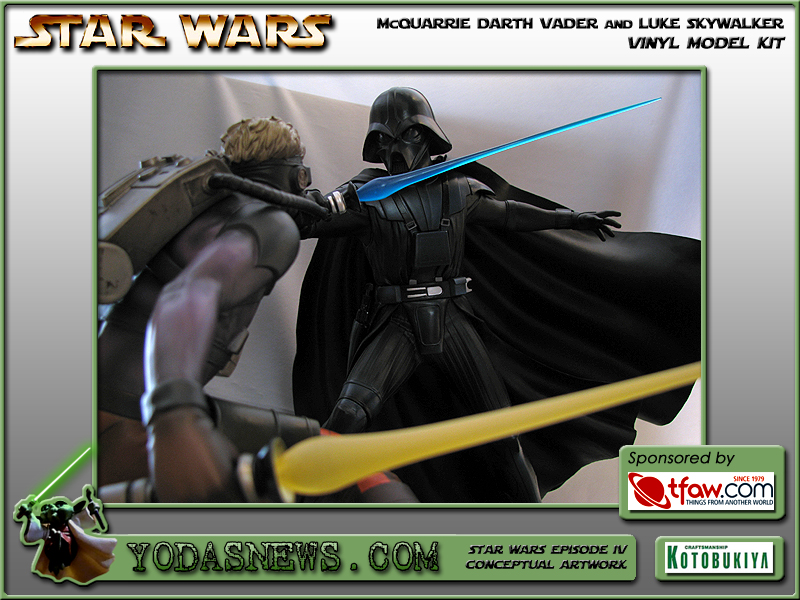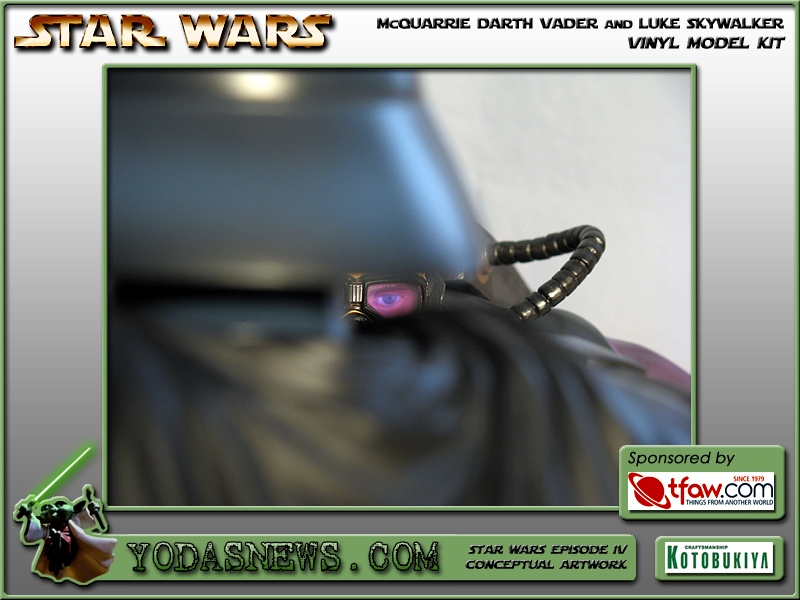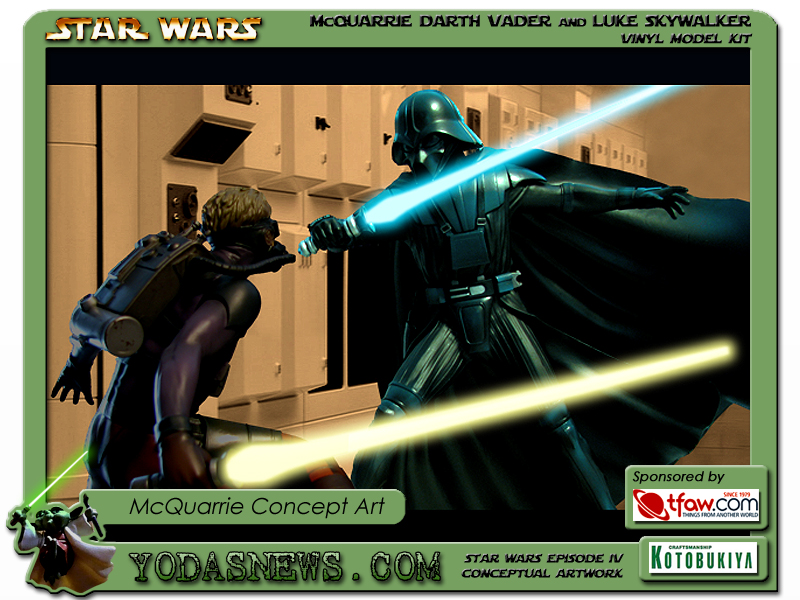Yodasnews Review: Darth Vader vs. Luke Skywalker (Vinyl Model Kit)
Based on the Ralph McQuarrie Conceptual Painting “Laser Duel”
Review and Photography by Jeffrey A. Gouse (SithLord0498) - Sponsored by Things From Another World (TFAW.com)
Review Date: December 1, 2008
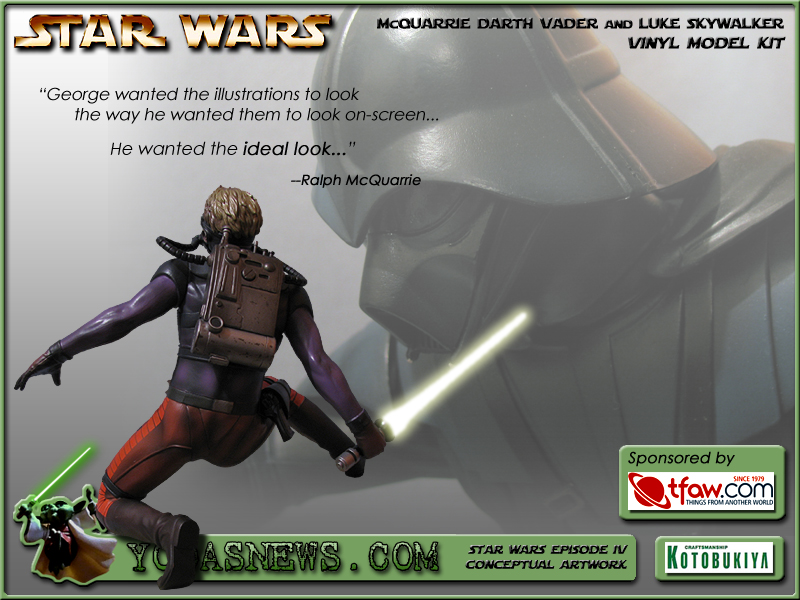
PRODUCT SPECIFICATIONS
In an age where summer blockbusters incur ever-increasing budgets and Star Wars itself has become an indelible part of modern global pop culture, it may seem unimaginable that there was a time where A New Hope was in danger of never being made because no one knew how much it would cost. Despite a keen interest in the script, Twentieth Century Fox (the only studio to express any faith in the story) was not going to green-light their option without a realistic budget proposal in hand. Of course, George Lucas and his colleagues could not provide that information without having a tangible idea of how Star Wars would look. Someone needed to pull the story off the pages and into full-fledged illustrated life for the very first time.
That “someone” was conceptual artist Ralph McQuarrie.
Working under Lucas’ mandate to paint what he’d like to see on screen and ignore the how and how much, McQuarrie produced a series of paintings that became the film’s visual pitch to Fox executives. What came after that is history.
Among those first paintings was McQuarrie’s depiction of an encounter between Darth Vader and hero Deak Starkiller (eventually revised into Luke Skywalker), lightsabers drawn and both wear breathing apparatuses. Dubbed “Laser Duel” by its artist, it is one of the most iconic concept paintings in the entire Star Wars saga. In celebration of A New Hope’s 30th anniversary, Kotobukiya commemorated the event by bringing this painting to three-dimensional life as the (coincidentally) 30th entry in their Star Wars ArtFX line. This model is unique in that it is the first time Kotobukiya delved into concept art for one of their products. In fact, it may even be the first time a Star Wars licensee crafted a larger-scale concept art sculpture. Another unique aspect is that it is the first ArtFX model to have a strict edition size, which was divided up among various regions across the globe. This particular sample is 1707 of the 3,030 available to North America.
Adapting a single painting into three-dimensional form can be a daunting challenge, but Kotobukiya’s artisans were determined to do it. Today’s review of the Conceptual Darth Vader vs. Luke Skywalker vinyl model will examine whether or not their gamble was a success.
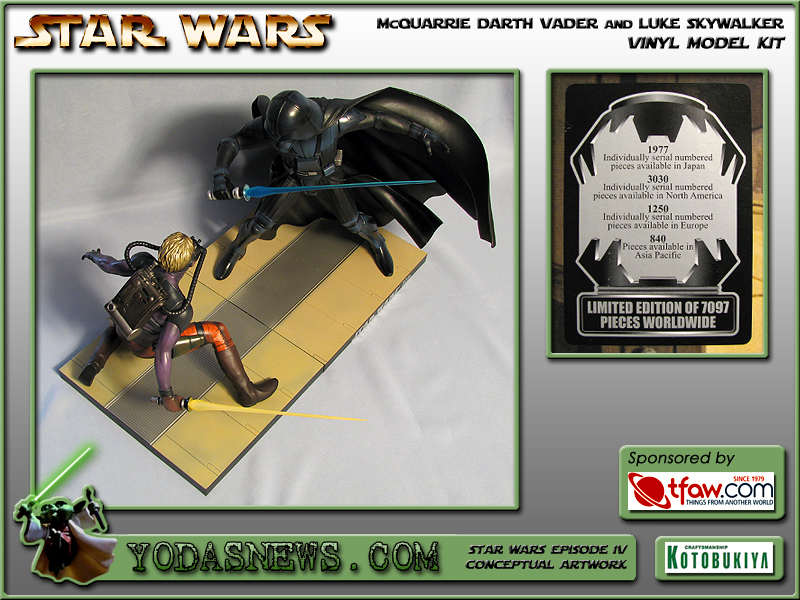
SCULPTING
DARTH VADER
Quality: Excellent
Accuracy: Above Average
Paging through the wealth of conceptual artwork produced for all six films in the Star Wars saga (McQuarrie, Chang, McCaig, etc.), one sees inspirations from all corners of the globe and a multitude of historical eras. Naboo was reminiscent of Renaissance-era Italy. Han Solo’s early renderings resembled a high-seas pirate in outer space. For Darth Vader, one can clearly see a dark samurai warrior wrapped in Middle Eastern garments. In fact, McQuarrie recalled that Lucas’ instructions for the Sith Lord described the villain as “a very tall, dark fluttering figure that had a spooky feeling like it came in on the wind”—and that is exactly what comes through in “Laser Duel”.
Kotobukiya successfully replicated the primal terror that McQuarrie conveyed in his iconic painting. The harsh angles and elongated features of Vader’ samurai-inspired helmet translated superbly to the model. The vents in the mouthpiece and the concave grooves of upper cheekbones sync up perfectly with the painting. One particularly unsettling feature of Concept Vader is his saucer-like eyes, which are reminiscent of traditional depictions of the Roswell aliens. Kotobukiya’s team of artists reproduced these beautifully. The sculptors also managed to leave behind all of their knowledge of Vader’s finalized cinematic form because none of that version’s refinements are included. Whereas the final Vader helmet had clearly defined angles and symmetry (in the case of the Episode III helmet) in the cheekbones, this conceptual model leaves things muddled and hard to visually discern. That only adds to the terrifyingly evil aura projected by this elemental vision of Vader. Ultimately, McQuarrie’s Vader is a man with very little in the way of human features, and Kotobukiya nailed this look perfectly.
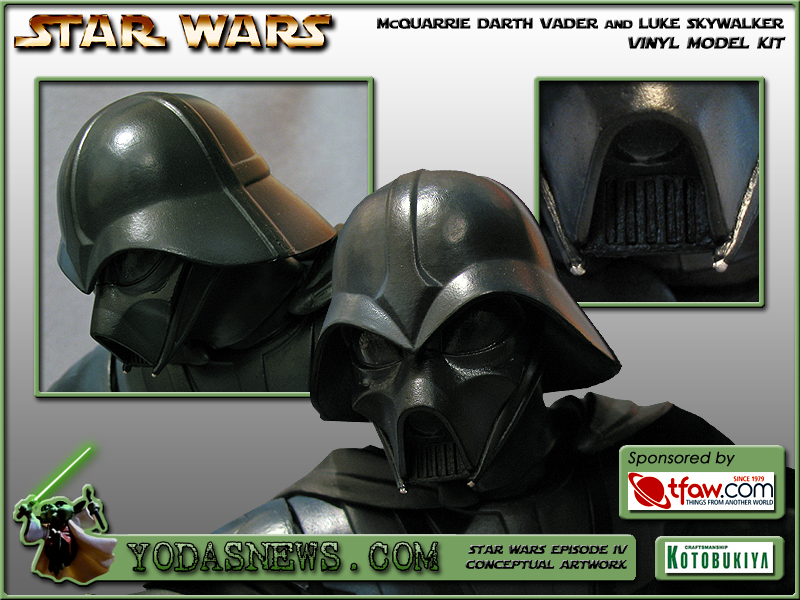
The model’s voluminous cape perfectly matches up with Lucas’ mandate to have Vader “all tied up in silk and rags” and to have “came in on the wind” because there is a massive amount of plastic here—so much that it nearly creates an imbalance in the model’s center of gravity. The harsh angles of its wind-swept look are most noticeable in a profile view, which is perfect since that is the orientation of the model when on display and viewed head-on. The best aspect of the cape’s sculpt is how it billows out behind Vader but suddenly angles back toward the front because it creates an intimidating and dramatic look when viewed at the proper angle.
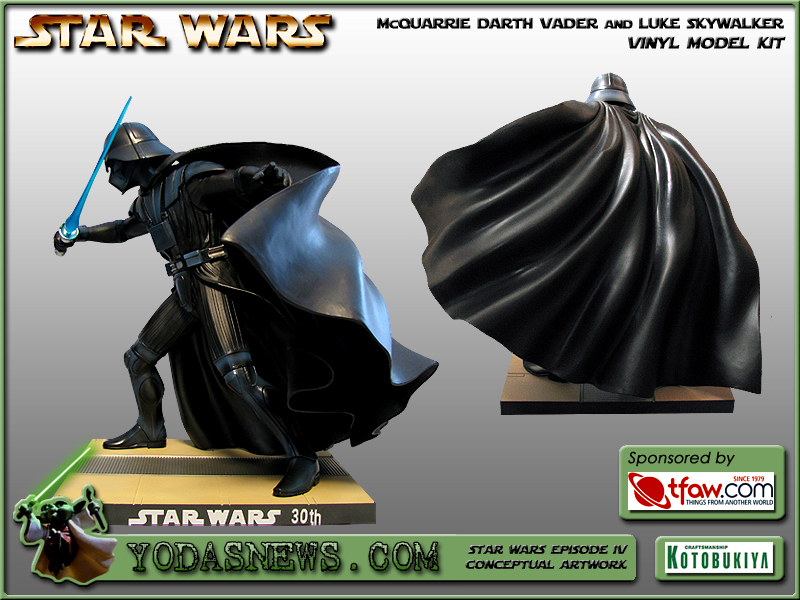
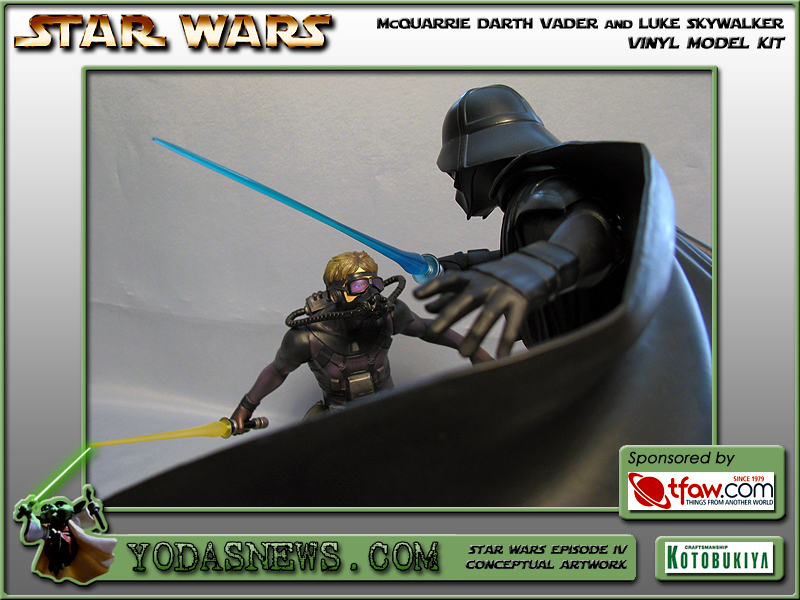
Vader’s armor has little in the way of nuanced details, but this aspect is faithful to the concept art. McQuarrie’s Vader uses simple lines and overlapping layers in the armored plates to create its enigmatic vibe, and Kotobukiya’s model captured that essence through its execution of the suit. They even managed to retain the inverted triangular form of the armor (the broad shoulder pads and breastplate form the base and tapers down to the rounded point of the codpiece). The shoulder pads and boots continue the diamond motif found on the front brow of the helmet—another aesthetic element accurately ported over from the painting. As for the fabric tunic, Kotobukiya’s sculptors created very natural and lifelike folds with the model’s tunic puffing out and then tightly tapering at the belt as real fabric would do.
The most impressive element is found in a very unlikely area—the lower body. When looking closely at the legs, one can see gracefully flowing contours in the plastic that unequivocally simulate tight and toned muscles bulging beneath form-fitting rubber. Of course, there is no underlying musculature, and everything is cast in soft vinyl. That it makes you temporarily forget that fact is what makes the artistry so impressive. The boots carry the same illusion with the calf muscles, but here Kotobukiya’s sculptors pull off the illusion of hard armor encasing the muscles. The end result is a hyper-realistic depiction of a much leaner and more athletic Sith Lord than the bulkier cinematic version.
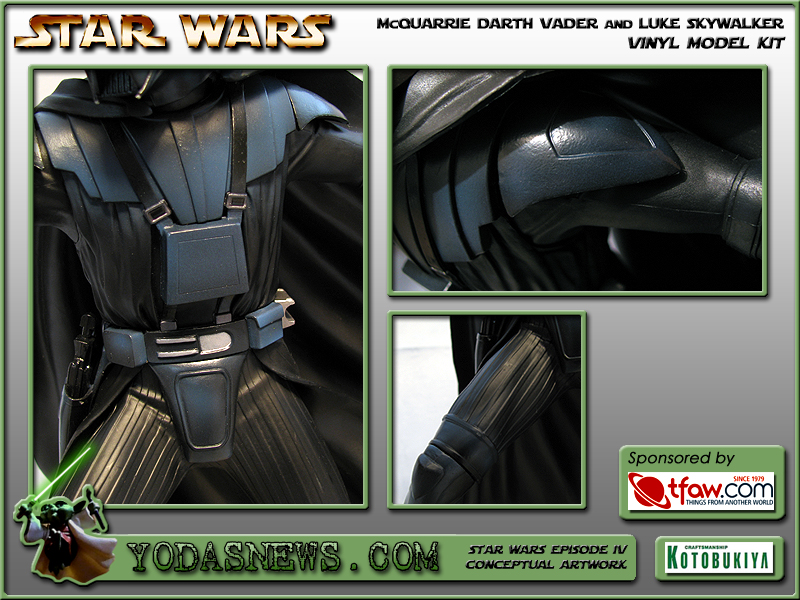
Finally, we come to Vader’s accessories—the removable lightsaber and the non-removable holstered blaster pistol. The blaster is nothing particularly spectacular, but the sculpting is very crisp and well defined. The holster is simplistic with gentle curves and a shape that matches the contour established by the “visible” part of the blaster pistol. Together, the two elements create an effective-enough illusion of an entire blaster seated in a functional holster. As for the lightsaber, this is more visually interesting even though it’s not entirely accurate. The rounded portions spaced out over the cylindrical core make Vader’s concept lightsaber look like a tall chess piece. The inaccurate part is that the concept art shows that the rounded areas should be blockier, but the chess piece look is much more intriguing.
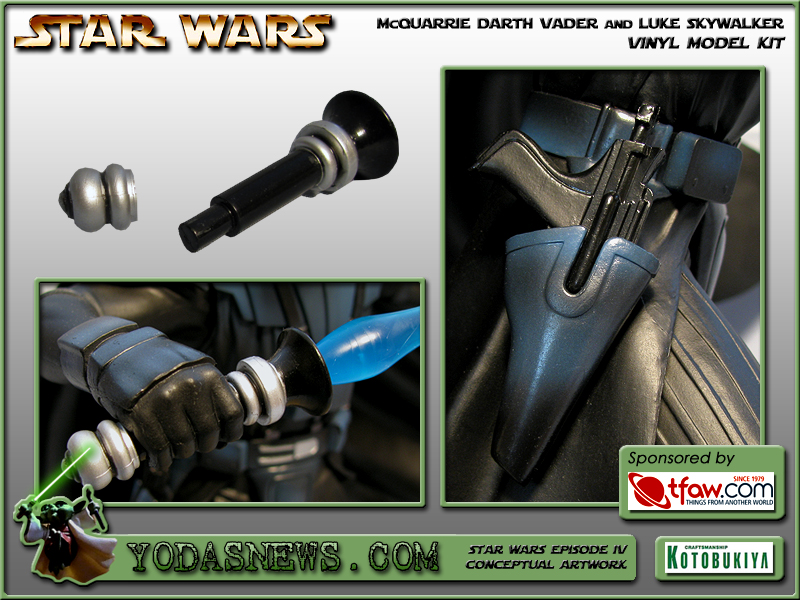
There are several inaccuracies between the model and the painting, but they are small and do not stand out unless one does a side-by-side comparison. Considering this is a three-dimensional interpretation of a painting and thus more open to creative license, none of these inconsistencies would have been enough to tarnish the sculptors’ work at all. However, the Accuracy rating only ranks “above average” because Kotobukiya essentially shot themselves in the foot with their blurb on the back of the box.
“The artisans of Kotobukiya have taken great pains to faithfully reproduce McQuarrie’s every detail…”
If you’re going to make an absolute claim like that, then make sure you do it.
As such, here are the areas in which Kotobukiya’s claim fails to hold water. The most prominent are the placement of Vader’s arms. The angles on both do not match up against the angles in the painting. The inclination of the saber-wielding arm is only a slight change, but the outstretched arm is completely and noticeably incorrect. McQuarrie painted the arm straight and swept back at a roughly 45 degree angle. Kotobukiya’s “faithfully reproduction” has the arm bend slightly at the elbow and elevates it to a near-90 degrees. The model’s arm was even checked for unadvertised articulation, but there is none. It is meant to be this way. Honestly, it’s baffling how that detail could have been missed by a team of artists working toward full authenticity. Additionally, the cape is too full and billowing. It looks fantastic and visually powerful on the model, but it’s not what the painting shows. Lastly, Kotobukiya added a saber clip on Vader’s belt that isn’t in the artwork, and the chest panel should be smooth and not have the subtle square groove etched on it.
That being said, all of the sculpted elements (including the inaccuracies) coalesce to form a very dramatic and imposing sculpture of the conceptual Dark Lord, and no erroneous claim can diminish that.
LUKE SKYWALKER: Excellent
A detailed examination of the conceptual “Deak Starkiller” (let’s just stick with Luke for simplicity’s sake) is significantly more difficult than Vader. “Laser Duel” gives us a clear frontal view of the Dark Lord whereas Luke is only seen from a rear angle and darkened by simulated shadows. Considering Hasbro made an action figure with many of the same details as this Kotobukiya model, McQuarrie obviously made more illustrations of this character, but they do not appear in any of the reference books currently used for Yodasnews product reviews.
So Luke will have to stand mostly on the merits of Kotobukiya’s execution of the piece and not as much on accuracy to the source material.
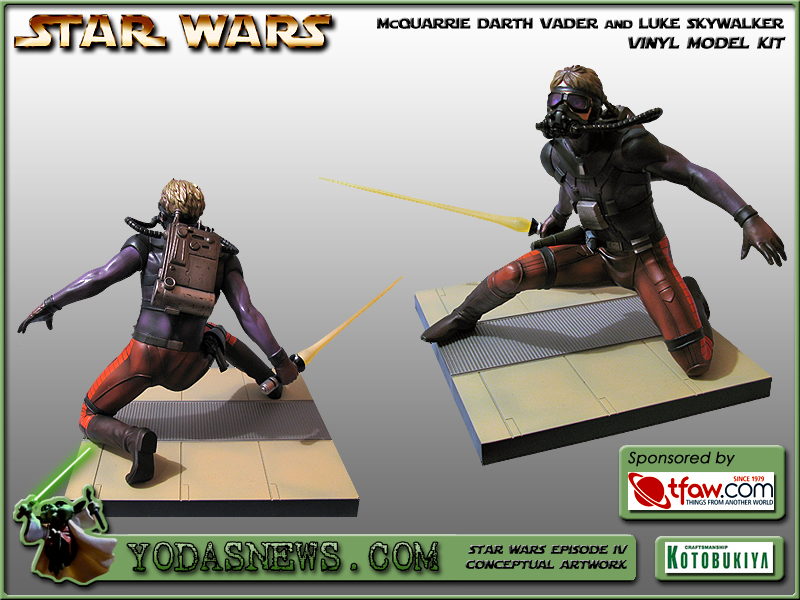
While there are many excellent qualities to this model, the best feature is undoubtedly the portrait. Kotobukiya’s sculptors were not content with merely crafting a masked Luke Skywalker with goggles and a breathing apparatus covering over 80% of his face. They went above and beyond by sculpting an entire portrait—of which they then concealed 80%. This exquisite attention to detail is representative of the “craftsmanship” so frequently attributed to this company. Granted, the portrait is generic and decidedly anime-flavored, but who really cares? First, this is a concept piece, so performer likeness is not an issue. Second, it remains covered for the most part. Yes, you can move the breathing mask away from the face, but the goggles are permanently sculpted over the face. However, that is another outstanding quality of this portrait. Rather than making opaque lenses, Kotobukiya went for authenticity and cast them in a translucent purple material, allowing people to see the underlying sculpted eyes. This feature alone propels the sense of realism off the charts.
The remainder of Luke’s head has been executed well too. The ruffled hair flows off in a wind-blown pattern, but it never becomes chaotic or overly messy. Creating a focal point for the part in Luke’s hair and gradually extending the length and smoothness of the clumps add to the realism as does the occasional overlapping onto Luke’s mask. The goggles were sculpted with such attention to detail that they look like miniaturized versions of the real thing—although the strap is not as three-dimensional as the rest of the eyewear. The breathing apparatus is simply an exaggerated, space-faring take on scuba diving gear, but the subtle details “breathe” life into the mechanical device (yes, pun intended). Examples of said details include the suction cup lip that presses against Luke’s face and the circular exhaust vent on the lower front portion of the mask.
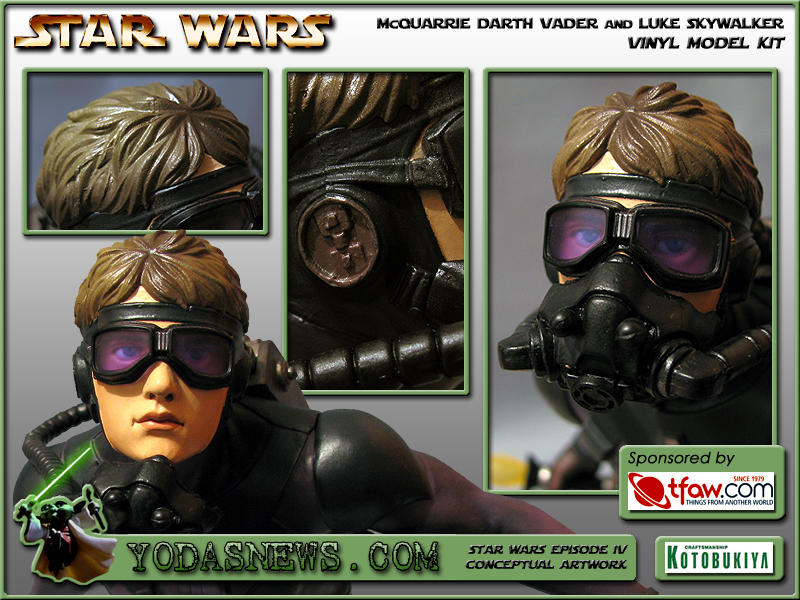
As with Darth Vader, Kotobukiya’s sculptors developed Luke as a model of physical fitness, and the illusion of toned muscles running beneath stretchy, form-fitted fabric is expanded upon for this character. Luke’s entire outfit is skin-tight, so the sculptors had to take into account how the body’s entire muscular structure would look in this dynamic crouched pose. What they created looks exceedingly lifelike. Whereas Vader’s muscles were most pronounced in the legs, Luke’s muscles are most impressive in the arms and neck. The contours reflect solid yet streamlined muscles, and the slight creases sculpted inside the elbows are spot-on realistic. The crinkling of the boots, in addition to effectively simulating real leather, conveys the impression of real ankles and feet within them, and the ripples and pulls of the pants between the crotch and thighs look very realistic. The same holds true for the wrinkles behind the bent knee. As they did on the Scout Trooper, Kotobukiya has created the impressive illusion of a real skeletal and muscular structure inside this sculpture.
Basic Anatomy 101 aside, other components of the sculpture are impressive as well. The oxygen mask is connected to a backpack that looks like it sprung off the pages of a Jules Verne story. The pack has a 19th century industrial feel to it with non-descript valves, dials, and plating in addition to a wide cylindrical drum on the bottom. Despite the large amount of “machined” elements here, Kotobukiya’s sculptors maintained control over the execution of each individual component. Every line and curve is the appropriate depth, and nothing here disturbs the pack’s realism. Even the oxygen hoses appear to buckle and stretch according to real-world physics. The small blue pouch on Luke’s utility belt looks like a miniaturized version of the real thing, and the etching on the belt buckle is sufficiently three-dimensional. The seams and knee pads on the pants look very real and authentic as well.
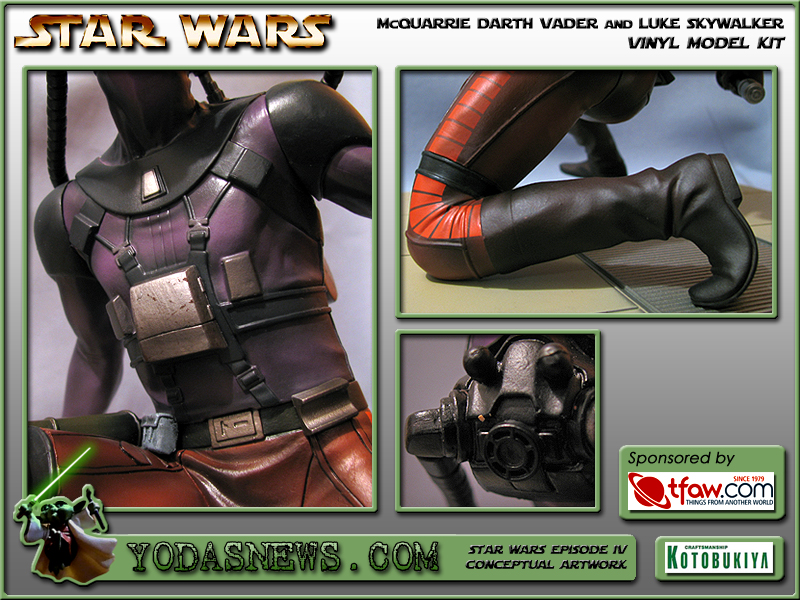
Luke’s lightsaber shares the same overall good quality as Vader’s lightsaber, so there isn’t too much to add here. One worthwhile note is that Luke’s saber adheres more closely to the blocky depiction shown in McQuarrie’s painting. The sculpted blaster pistol is the better of the two weapons in this case however. From the small part visible, it looks like a real-world handgun as opposed to the decidedly-futuristic look of Vader’s blaster. Notable points of interest with regards to the sculpting are the finely-etched pistol grip and accompanying “screws” as well as the ridged gear-like piece above the grip.
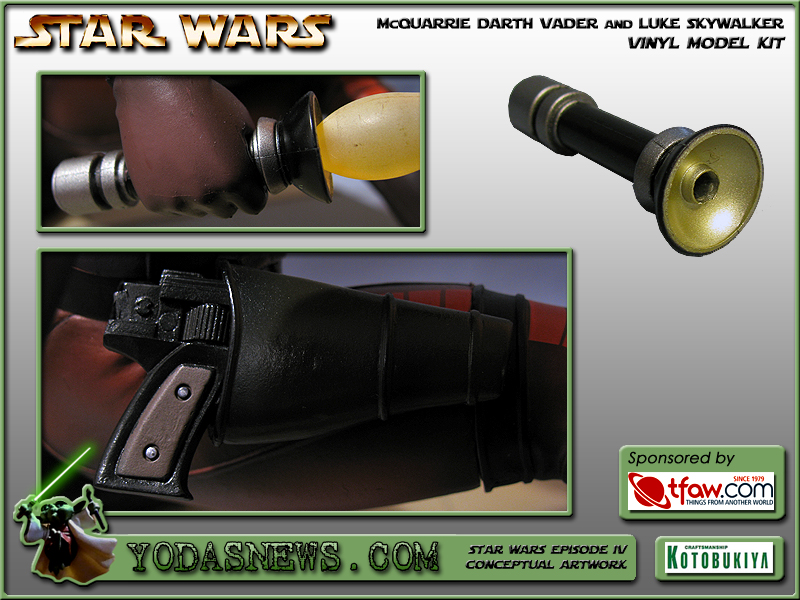
Naturally, there are some issues with the sculpture. The straps and buckles on Luke’s shirt look too shallow and lack the three-dimensional quality shared by many other aspects of the model. Additionally, the point where the shirt meets the belt looks particularly fake because Kotobukiya’s sculptors failed to add a bunching and tapering effect. There is no illusion of depth or realism. Instead, it just looks like two pieces of a model kit attached to each other.
Beyond those minor qualms, the sculpting is impeccable.
PAINT APPLICATIONS
DARTH VADER: Excellent (Bordering on Above Average)
Kotobukiya used a different style of painting on this particular model. Rather than approach the piece with an eye toward realism, their artists used an airbrushing method that blended various shades and hues to create an effect best described as “a painting brought to life”. This is, quite honestly, the only approach that could have worked here since this is a 3-D realization of a concept painting.
Because of Vader’s dark color palette, the paint applications are minimal with only splashes of gray and blue spread out across black. Yet they are not random. They correspond to the blue highlights seen in McQuarrie’s work. However, there are areas in which Kotobukiya took artistic liberties with the color palette. The areas in question are the buckles on the chest straps and the center etching on the belt. McQuarrie’s painting cast them in the same blue as the rest of the armor whereas Kotobukiya painted them silver. As with the sculpting, none of these aesthetically hinder the model, but it brings into question just how “faithfully” Kotobukiya worked to reproduce McQuarrie’s art.
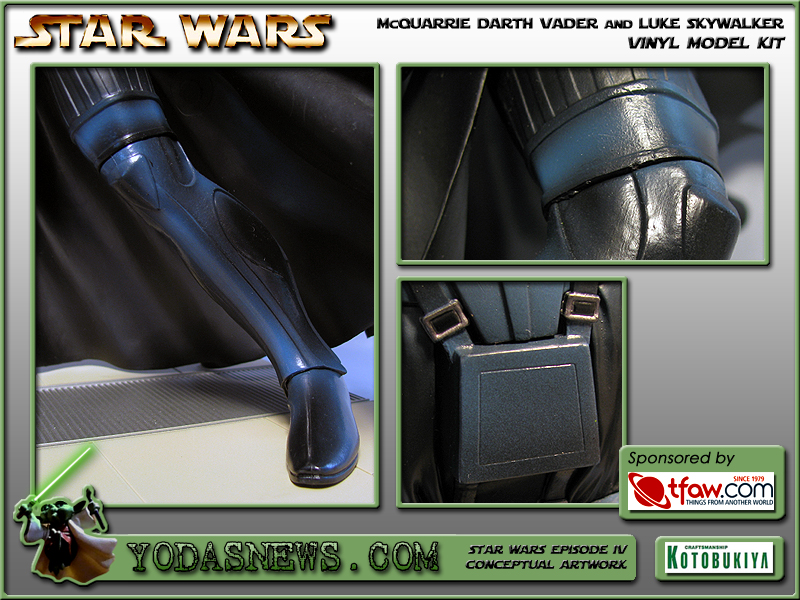
LUKE SKYWALKER: Excellent
Not surprisingly, Kotobukiya took the same approach with Luke’s paint applications. The airbrushing here has an overall purplish tone thanks to Luke’s purple shirt and wine-colored pants. Shadows generated by the natural contours of the sculpture are augmented by black airbrushing, an element not heavily featured on Vader since he already had such a dark color palette. Luke’s hair is airbrushed with varying shades of brown and tan. Essentially, Luke’s applications tend to run more realistic as opposed to the abstract nature of Darth Vader’s applications. Contrasting with the gentle gradations of the airbrushed pants, the Corellian blood-stripe patterns running down Luke’s legs are crisp, evenly spaced, and done with machine-like precision.
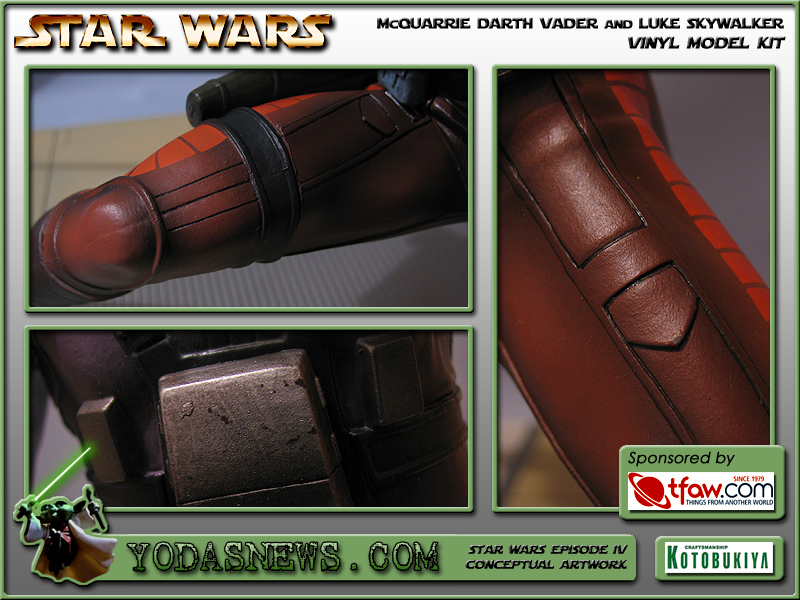
Other areas came out excellent as well. The lips have been cleanly applied. They are very pink, but that actually fits in nicely with the entire approach used on this set. It gives the face a more anime look as well as simulating the look of a painting. The skin tone around the mouth is also glossier than it should be. However, all of this is ultimately inconsequential because the lower face is completely covered by the oxygen mask. Kotobukiya deserves high marks for even taking the time to do as good of a job as they did on the portrait. Besides that, their painters absolutely nailed the one facial feature that does matter—the eyes. Luke’s blue eyes are painted with a high level of precision that shines through the translucent lenses which permanently encase them, and that adds a remarkable amount of life to the face. Additionally, the chest panel and backpack both feature the most realistic chipped paint deco ever seen by this reviewer on a Star Wars collectible. The randomness of the chipping as well as the varying shades of paint used successfully conveys the illusion of a battle-worn metal apparatus.
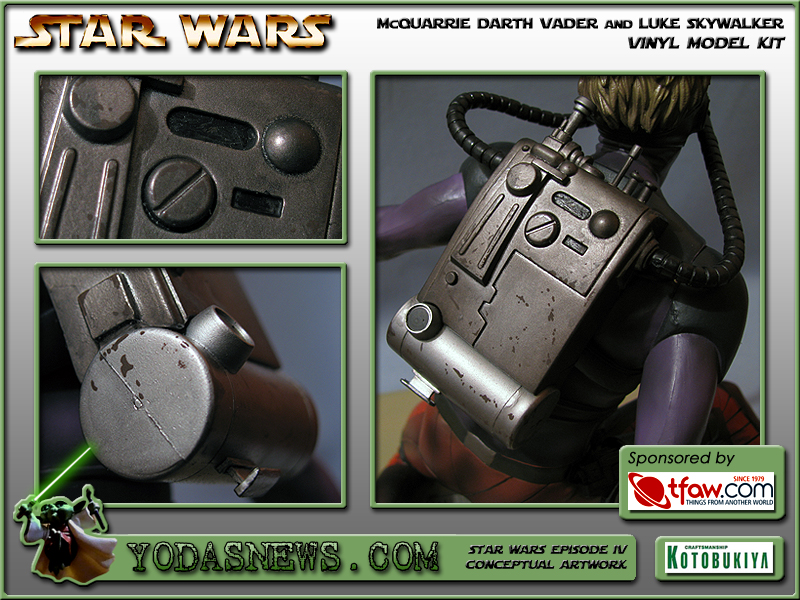
DISPLAY BASE: Average (Bordering on Above Average)
Because “Laser Duel” only shows the action from above Vader’s shins, there is no visual reference Kotobukiya could have used when creating the display base. Thus, it is a purely interpretive design that is meant to be a logical extension of the visible architecture (i.e. – the starship corridor walls). In order to give collectors the choice to display the models separately, the corridor base is divided in half. Focusing only on the tops, these are fine-looking bases with cleanly etched lines in the floor panels and a consistent ridged effect on the “metal” strip running down the center. However, the bases have some glaring issues. First, they merely slide together to allow the models to be displayed in diorama form. Combine the lack of any connectors with the featherweight mass of the bases, and one finds it very difficult to keep them from sliding around. The second issue involves the text on each base. Luke’s base reads “Kotobukiya ArtFX #30”, and Vader’s base reads “Star Wars 30th”. Clearly, these are meant to be commemorative plaques of sorts, but they are on opposite sides. When displayed properly, only “Star Wars 30th” is visible, and even that isn’t cleanly sculpted on the plastic. If one tries to reverse Luke’s base to keep the text on the same side, then the sculpting on the top does not match up with Vader’s base.
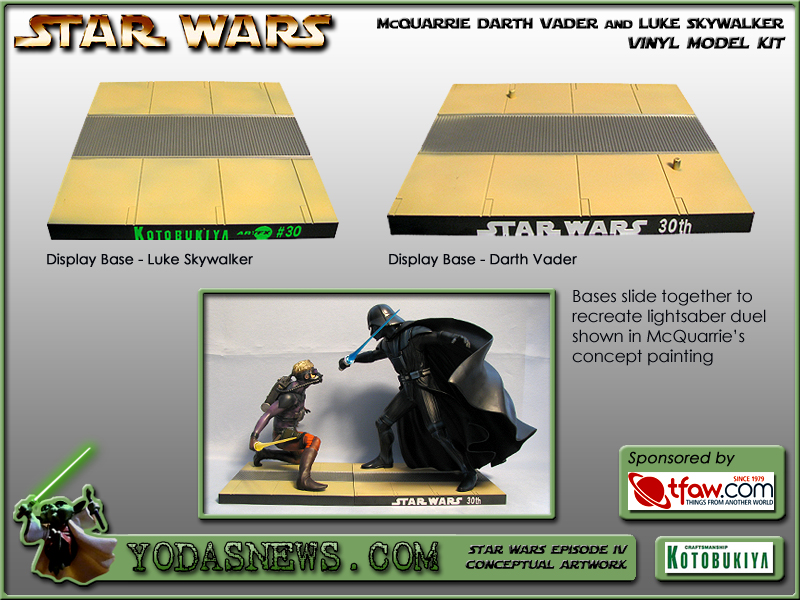
EASE OF ASSEMBLY and DURABILITY: Excellent
At twenty pieces, this is probably Kotobukiya’s most elaborate model kit yet, but its assembly retains the simplicity and ease of earlier models like the Scout Trooper, Snowtrooper, and Yoda. All of the pieces slide together easily and hold firmly in place. The lightsaber hilts are the only “complicated” parts because they require disassembly before assembly. First, pull off the bulbous bottom to reveal a peg inside (an example of which was shown earlier in this review). Slide the upper part into the top of the character’s fist, and the peg will poke out of the bottom. Reconnect the bulb, and the saber is now clutched in the figure’s hand. The only other part that requires extra attention is ensuring Luke’s line of sight matches up with Vader’s eyes—the reason for which will be explained shortly.
In terms of durability, this is a solid product. There are no brittle parts over which to sweat bullets, and that is a welcome relief after the C-3PO and R2-D2 set. The lightsaber blades do run a higher risk of breakage in the event of a shelf-dive, but this is hardly anything new for Star Wars collectors. The only other potential issue is that Luke simply rests on the base without the aid of foot pegs or other connectors. However, the model’s center of gravity is superbly balanced due to the distribution of the vinyl’s mass and the placement of the feet and downed knee. Barring a significant impact, Luke is not going to fall over while on display. The most irritating part about this was mentioned above—it is up to the collector to correctly orient Luke’s position relative to Vader.
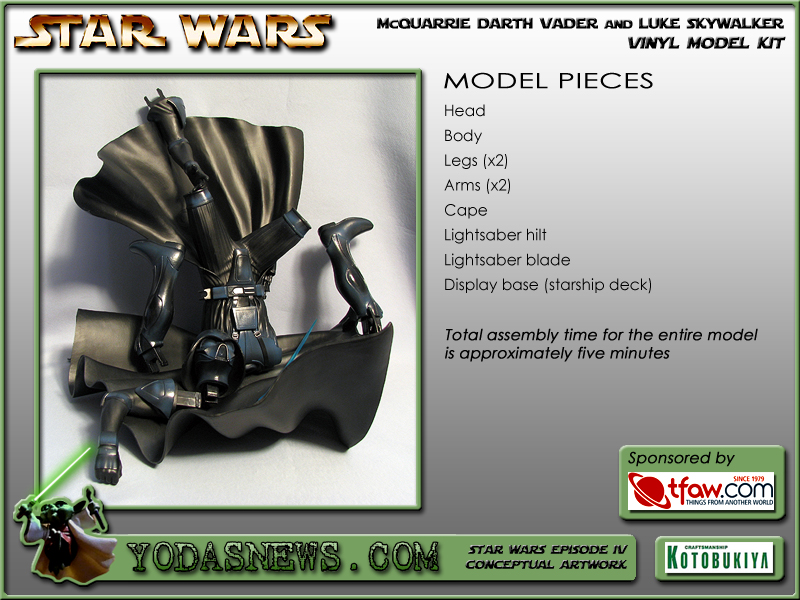
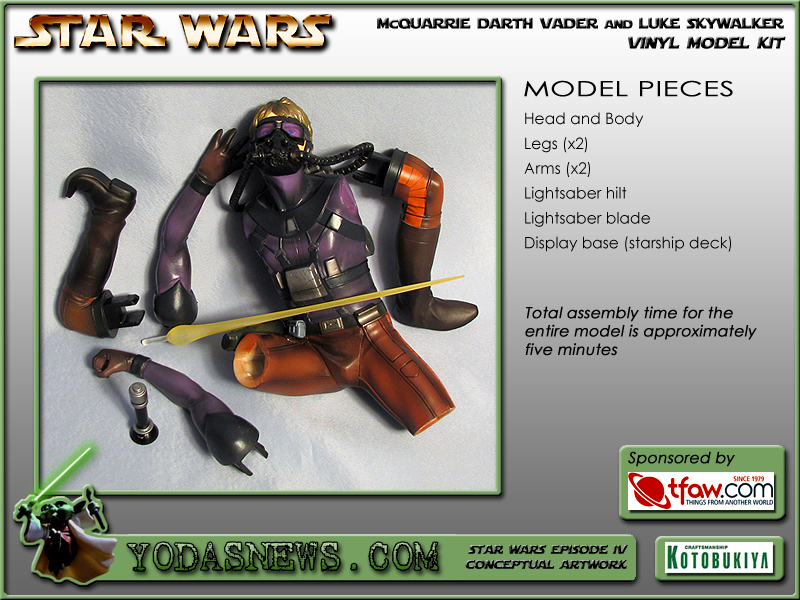
OVERALL RATING: Excellent
In these economically troubling times and with the steepest price tag in the entire Star Wars ArtFX line ($200), the McQuarrie Darth Vader vs. Luke Skywalker model kit needs to fire on all cylinders to justify its worth to collectors, and Kotobukiya made sure it did just that. It may not be an exact duplicate of what Ralph McQuarrie depicted over thirty years ago (regardless of what Kotobukiya claims), but the sculpting is exquisitely first-rate and captures the spirit of both the painting and Star Wars itself. Kotobukiya’s artists also did a fantastic job with the “painting come to life” illusion on this model. The only real shortcomings are the construction and functionality of the display base, but they only surface when moving the model.
Fortunately, the McQuarrie piece is part of the massive Kotobukiya holiday sale at Things From Another World (TFAW.com), so it is a very affordable $99.98 (the sale price will show once the item is in your shopping cart). At that price, this is an absolute must-buy and will be an exceptional centerpiece for any Star Wars display. Art displays and home theater rooms could also benefit from this model’s inclusion simply because of this sculpture’s artistic origins.
One last thought for you, dear readers…
Considering today is “Cyber Monday” (“Black Friday” for Internet retailers), the McQuarrie Darth Vader vs. Luke Skywalker vinyl model kit would also make the perfect holiday gift for the Star Wars collector in your life. It’s unique. It’s a fantastic work of art. It’s affordable.
You couldn’t ask for anything more.
Reviewer’s Note: Background information on McQuarrie’s concept work referenced from “The Making of Star Wars” by J.W. Rinzler (Del Rey, 2008)
